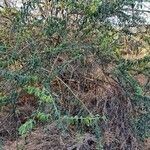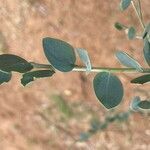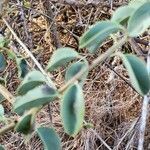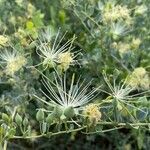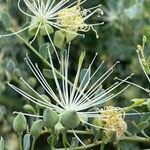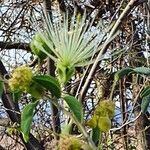Small shrub c. 1 m tall (rarely up to 2-4 m), branched from base, glaucous, glabrous; branches smooth, green. Leaves simple, petiolate; lamina ovate to broadly ovate, 1.5-2.7 cm long, 1.2-2.0 cm wide, apex round, mucronate, base rounded, 3-5-veined near base; petiole 4-5 mm long. Flowers axillary, solitary, towards the ends of the branches; pedicels 1.2-2 cm long. Receptacle infundibular, 1.5-2.5 mm long, 2.5-3.0 mm wide at mouth; disc coronate, undulate or denticulate, 1.5-2 mm long. Sepals 3(4), elliptic-ovate, 1.4-1.6 mm long. Petals 0. Androphore 4-5 mm long, exserted about 1.5-2.0 mm. Stamens 40-65, 2.0-2.5 cm long, conspicuously apiculate. Gynophore 2.5 cm long, usually recurved when mature. Ovary 6 mm long, ellipsoid, narrowed at both ends, 2-celled; ovules 4; stigma capitate. Fruit globose, 1.8-3.0 cm diam., 'smooth', yellow-orange when ripe. Seeds 1-4, discoid, up to 2 cm diam., 0.5 mm thick.
More
A small shrub. It grows 3 m high. It often has several stems. It has a tuberous rootstock. The leaves are alternate and simple. The leaves are broadly oval and greyish-green. They are rough. The flowers are usually white or greenish-yellow. They are produced singly in the axils of the upper leaves. The fruit are oval and 3 cm long. They are on long stalks. The fruit are yellow or orange when ripe. They contain 1-4 seeds
Small glaucous shrub, up to 1 m high. Leaves simple, ovate. Sepals usually 3. Fruit smooth, globose, borne on recurved gynophore. Flowers greenish white.
It is a tropical plant. It grows in dry bushland and on sandy or light clay soils. It grows in low rainfall woodlands. It grows at low altitude. It grows in hot dry arid places. In Tanzania it grows from sea level to 1,800 m above sea level.
The ripe fruit are sucked and are sweet. The seeds are boiled for 3-4 hours with the water being changed 4-6 times and are then eaten. Alternatively the seeds are soaked for 2 days then rinsed and cooked. The roots are added to water to make it sweet then used as a drink. The root is pounded and used in soup. The root bark is chewed for its sweet taste. Caution: Many plants in this group need careful preparation.
